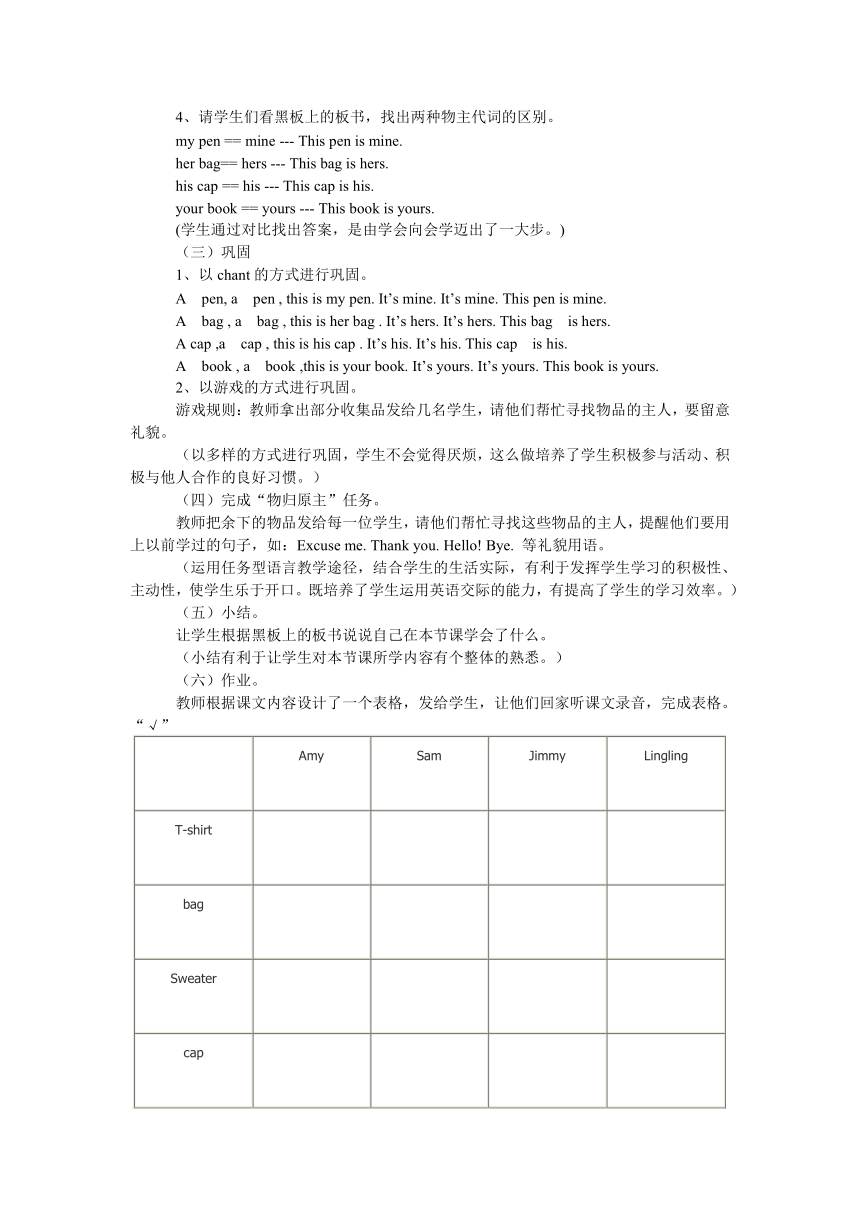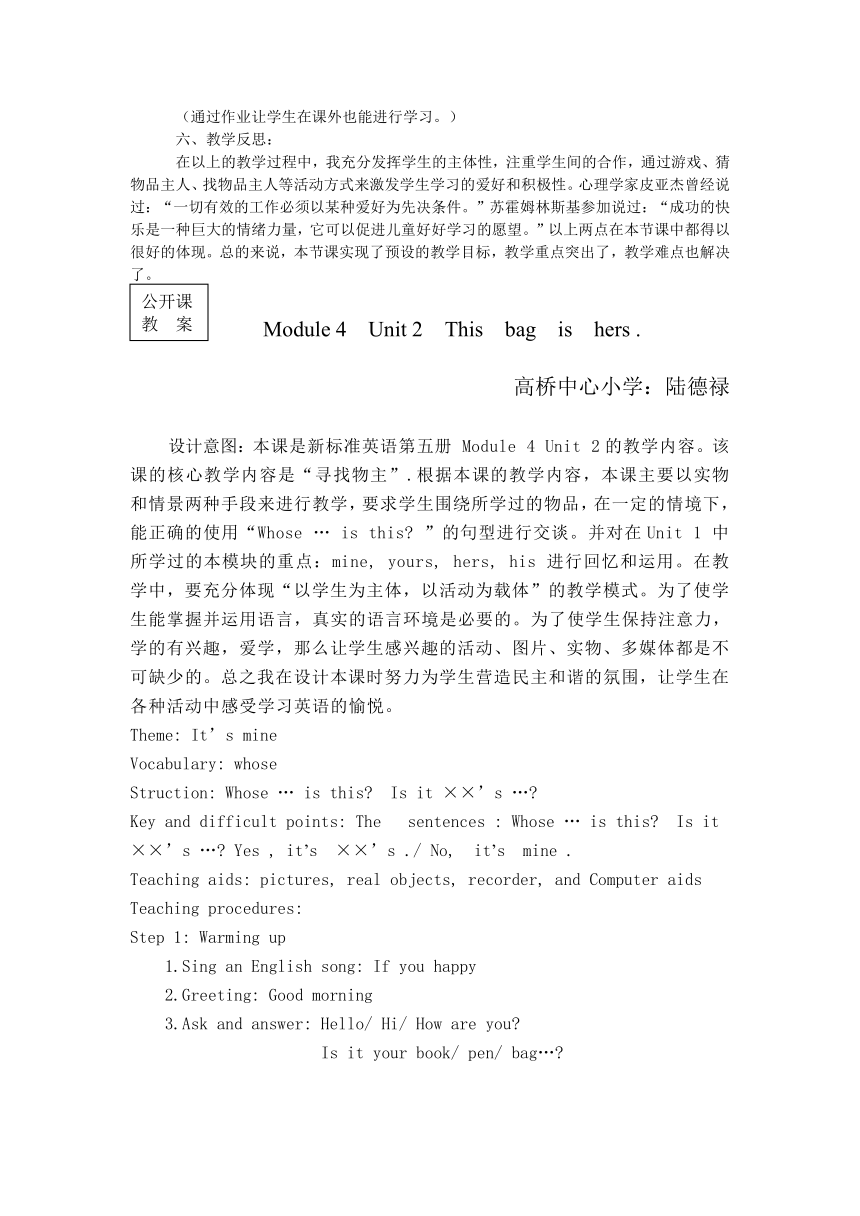This bag is hers.
文档属性
| 名称 | This bag is hers. |  | |
| 格式 | zip | ||
| 文件大小 | 17.3KB | ||
| 资源类型 | 教案 | ||
| 版本资源 | 外研版(三年级起点) | ||
| 科目 | 英语 | ||
| 更新时间 | 2011-11-19 13:43:07 | ||
图片预览



文档简介
This bag is hers.教学设计
一、教学目标:
1、知识目标:理解和把握句型This bag is hers.以及单词mine、yours、his、hers。
2、能力目标:培养学生用所学知识来指出事物的主人,以及用所学知识来获取他人信息的能力。
3、德育目标:激发学生学习英语的爱好,养成积极参与活动、积极与他人合作的良好习惯。
二、教学重点:理解和运用名词性物主代词。
三、教学难点:区分形容词性物主代词和名词性物主代词。
四、教具预备:收集部分学生的学习用品。
五、教学过程:
(一) 热身及复习
做Simon Says游戏。
运用句型Touch your . Point to his/ her/ my .
(运用全身功能反应法进行Simon Says游戏,既活跃了课堂气氛,又使学生快速进入思维状态,同时也复习了旧知识——形容词性物主代词,为下面的学习埋下伏笔。这么做符合小学生的年龄特征。)
(二)新知识的呈现及操练
1、呈现mine及操练
①教师拿出以收集的物品之一 ——pen问:Whose pen is this
Pen的主人站起往返答:It’s my pen.
②教师拿出自己的钢笔问:Whose pen is this
学生们回答:It’s Mr Lu’s pen..
教师接着说:Yes, it’s my pen.
It’s mine. This pen is mine.(板书并带读)
③教师再问刚才那位Pen的主人:Is this your pen
引导那位学生回答:Yes. It’s mine. This/ That pen is mine.
④教师继续以同种方式进行操练。
(以旧引新,自然过渡,学生不回觉得太难,可以消除学生胆怯的心理。)
2、呈现his、hers及操练。
以的方式进行呈现及操练:要求学生闭上眼睛,教师拿某一位学生的书包,(要求书包主人不参加游戏),然后让学生睁开眼睛,
师问:Whose bag is this
很快,书包主人的同桌就发现了答案:It’s Lili’s bag.
教师对该学生的答案给予肯定:Yes. You are right. It’s her bag. It’s hers. This bag is hers.(回应课前以板在黑板上的课题并带读。)
以同种方式引出his板书并操练。
(运用任务型教学模式,通过游戏的方式对新内容进行呈现及操练,激发了学生的学习爱好和学习积极性,实现任务目标,让学生感受到成功的快乐,达到使学生乐学的目的。) 3、呈现yours及操练
以接近第一种的呈现方式进行呈现及操练。
师:Whose book is this
生:It’s mine. This ruler is mine.
师:Oh, it’s your ruler. It’s yours. This ruler is yours. (板书并带读)
4、请学生们看黑板上的板书,找出两种物主代词的区别。
my pen == mine --- This pen is mine.
her bag== hers --- This bag is hers.
his cap == his --- This cap is his.
your book == yours --- This book is yours.
(学生通过对比找出答案,是由学会向会学迈出了一大步。)
(三)巩固
1、以chant的方式进行巩固。
A pen, a pen , this is my pen. It’s mine. It’s mine. This pen is mine.
A bag , a bag , this is her bag . It’s hers. It’s hers. This bag is hers.
A cap ,a cap , this is his cap . It’s his. It’s his. This cap is his.
A book , a book ,this is your book. It’s yours. It’s yours. This book is yours.
2、以游戏的方式进行巩固。
游戏规则:教师拿出部分收集品发给几名学生,请他们帮忙寻找物品的主人,要留意礼貌。
(以多样的方式进行巩固,学生不会觉得厌烦,这么做培养了学生积极参与活动、积极与他人合作的良好习惯。)
(四)完成“物归原主”任务。
教师把余下的物品发给每一位学生,请他们帮忙寻找这些物品的主人,提醒他们要用上以前学过的句子,如:Excuse me. Thank you. Hello! Bye. 等礼貌用语。
(运用任务型语言教学途径,结合学生的生活实际,有利于发挥学生学习的积极性、主动性,使学生乐于开口。既培养了学生运用英语交际的能力,有提高了学生的学习效率。)
(五)小结。
让学生根据黑板上的板书说说自己在本节课学会了什么。
(小结有利于让学生对本节课所学内容有个整体的熟悉。)
(六)作业。
教师根据课文内容设计了一个表格,发给学生,让他们回家听课文录音,完成表格。“√”
Amy
Sam
Jimmy
Lingling
T-shirt
bag
Sweater
cap
(通过作业让学生在课外也能进行学习。)
六、教学反思:
在以上的教学过程中,我充分发挥学生的主体性,注重学生间的合作,通过游戏、猜物品主人、找物品主人等活动方式来激发学生学习的爱好和积极性。心理学家皮亚杰曾经说过:“一切有效的工作必须以某种爱好为先决条件。”苏霍姆林斯基参加说过:“成功的快乐是一种巨大的情绪力量,它可以促进儿童好好学习的愿望。”以上两点在本节课中都得以很好的体现。总的来说,本节课实现了预设的教学目标,教学重点突出了,教学难点也解决了。
Module 4 Unit 2 This bag is hers .
高桥中心小学:陆德禄
设计意图:本课是新标准英语第五册 Module 4 Unit 2的教学内容。该课的核心教学内容是“寻找物主”.根据本课的教学内容,本课主要以实物和情景两种手段来进行教学,要求学生围绕所学过的物品,在一定的情境下,能正确的使用“Whose … is this ”的句型进行交谈。并对在Unit 1 中所学过的本模块的重点:mine, yours, hers, his 进行回忆和运用。在教学中,要充分体现“以学生为主体,以活动为载体”的教学模式。为了使学生能掌握并运用语言,真实的语言环境是必要的。为了使学生保持注意力,学的有兴趣,爱学,那么让学生感兴趣的活动、图片、实物、多媒体都是不可缺少的。总之我在设计本课时努力为学生营造民主和谐的氛围,让学生在各种活动中感受学习英语的愉悦。
Theme: It’s mine
Vocabulary: whose
Struction: Whose … is this Is it ××’s …
Key and difficult points: The sentences : Whose … is this Is it ××’s … Yes , it’s ××’s ./ No, it’s mine .
Teaching aids: pictures, real objects, recorder, and Computer aids
Teaching procedures:
Step 1: Warming up
1.Sing an English song: If you happy
2.Greeting: Good morning
3.Ask and answer: Hello/ Hi/ How are you
Is it your book/ pen/ bag…
创设英语学习的氛围,激发学生的学习兴趣,组织教学。并通过问答复习学生学过的本模块的重点单词:Mine yours his hers
Step 2: Presentation
1.T: Boys and girls, please look at here. What are these (Teacher shows the pictures about sweater, T-shirt, bag and cap) Do you remember them
Ss read the words
T: Very good! Look at these words we learnt last lesson. Please read them.(Teacher uses the word’s cards )
Ss: mine yours hers his
2.T: Now look at here. (Teacher shows the picture of sweater and word’s card of mine)
Sweater, sweater, this sweater is mine.
Ss: Sweater, sweater, this sweater is mine.
Teacher uses the same method goes through all four pictures and four word’s cards: T-shirt, T-shirt, this T-shirt is yours. ect.
3.Group work
通过色彩鲜艳,直观性强的图画复习了学过的单词,并用单词卡片把学生记忆深处的单词和本模块的重点单词联系起来,达到运用的目的。
4.Teacher finds an apple from the desk.
T: Oh, an apple. I like eating apple. It’s delicious. (教师做吃苹果状)
But it isn’t mine. And whose apple is this
T: Whose apple is this Is it you apple
S1: Yes, it’s mine. / No, this is ××’s apple.
5.Teacher uses the real objects that the students took before to do more practice. And that the whole class know the means of the word ” whose ” and the sentences “whose … is this ”
6.T: Are you clear now. Please practice the sentence and make a similar dialogue in your group.
7.Teacher asks some groups to show in front.
提出任务,在语境中呈现新句型,把学生已知的实物及本单元的重点单词融入句型教学中,做到词不理句、句不离篇。叫学生带自己喜欢的水果、文具、小玩具等,增加了学生的直观性,提高了他们的学习兴趣,有助于学生对所学内容的理解,为新授内容的学习做好准备。
Step 3: Lesson’s learning
1. T: Turn to page 16. Activity one
2. Ss listen to the tape and repeat
3. T: Listen to me carefully. And try to ask my questions.
T: Whose sweater is this (points to group1 )
Gorup1: It’s Amy’s sweater
Teacher points the T-shirt and lets the group1 ask and group2 answer.
Group1: Whose T-shirt is this
Group2: It’s Sam’s T-shirt.
Teacher points the bag and lets the group2 ask and group3 answer.
Group2: Whose bag is this
Group3: It’s Lingling’s T-shirt.
Teacher points the cap and lets the group3 ask and group4 answer.
Group3: Whose cap is this
Group4: It’s Jimmy’s T-shirt.
经过反复的新句型练习后,在学生基本上掌握了新句型后回到文本教学,并用活动2进行巩固确保绝大部分学生都能掌握课文内容。
Step 4: Game “Find the Lost”
1. The teacher collects some students’ real objects to the teacher’s desk., lets students to guess whose things are these, and uses the sentence: whose … is this
Eg: T: whose cat is this
S1: Is it Lily’s cat
T: Is it your cat
Lily: Yes, it’s mine / No, its Lucy’s cat.
2. One student from each group, to come in front and have competition.
课堂结尾是巩固新知的重要环节。利用游戏和竞赛避免了反复朗读或问答的枯燥,在学生的易疲劳期最大程度的调动学生的学习主动性,取得“学中乐”的效果。
Step 5: Homework
Listen and repeat more times .
Copy the new words .
Blackboard
Module 4 Unit 2 This bag is hers .
Whose bag is this
Is it Amy’s bag
Yes, it’s hers .
No, it’s mine .
教学反思:
本节课主要是让学生学习名词性物主代词的使用。教师先复习已经学过的物品名称,为新课做准备,再以游戏形式导入新课,然后通过课件引导学生对“Whose … is this Is it ××’s … Yes , it’s ××’s ./ No, it’s mine .”这些句型形成比较直观的认识,再引导学生模仿例句开展招领失物活动,整个教学活动形式多样,操练分层有序。课上,以自主学习和交际运用为主导,学生在轻松愉快的氛围中学习语言,因而他们的学习兴趣浓厚,能主动参与各种课堂活动,但在活动前教师的示范性还不够强,今后应加以改进,以便更好地提高活动效率。
公开课
教 案
一、教学目标:
1、知识目标:理解和把握句型This bag is hers.以及单词mine、yours、his、hers。
2、能力目标:培养学生用所学知识来指出事物的主人,以及用所学知识来获取他人信息的能力。
3、德育目标:激发学生学习英语的爱好,养成积极参与活动、积极与他人合作的良好习惯。
二、教学重点:理解和运用名词性物主代词。
三、教学难点:区分形容词性物主代词和名词性物主代词。
四、教具预备:收集部分学生的学习用品。
五、教学过程:
(一) 热身及复习
做Simon Says游戏。
运用句型Touch your . Point to his/ her/ my .
(运用全身功能反应法进行Simon Says游戏,既活跃了课堂气氛,又使学生快速进入思维状态,同时也复习了旧知识——形容词性物主代词,为下面的学习埋下伏笔。这么做符合小学生的年龄特征。)
(二)新知识的呈现及操练
1、呈现mine及操练
①教师拿出以收集的物品之一 ——pen问:Whose pen is this
Pen的主人站起往返答:It’s my pen.
②教师拿出自己的钢笔问:Whose pen is this
学生们回答:It’s Mr Lu’s pen..
教师接着说:Yes, it’s my pen.
It’s mine. This pen is mine.(板书并带读)
③教师再问刚才那位Pen的主人:Is this your pen
引导那位学生回答:Yes. It’s mine. This/ That pen is mine.
④教师继续以同种方式进行操练。
(以旧引新,自然过渡,学生不回觉得太难,可以消除学生胆怯的心理。)
2、呈现his、hers及操练。
以的方式进行呈现及操练:要求学生闭上眼睛,教师拿某一位学生的书包,(要求书包主人不参加游戏),然后让学生睁开眼睛,
师问:Whose bag is this
很快,书包主人的同桌就发现了答案:It’s Lili’s bag.
教师对该学生的答案给予肯定:Yes. You are right. It’s her bag. It’s hers. This bag is hers.(回应课前以板在黑板上的课题并带读。)
以同种方式引出his板书并操练。
(运用任务型教学模式,通过游戏的方式对新内容进行呈现及操练,激发了学生的学习爱好和学习积极性,实现任务目标,让学生感受到成功的快乐,达到使学生乐学的目的。) 3、呈现yours及操练
以接近第一种的呈现方式进行呈现及操练。
师:Whose book is this
生:It’s mine. This ruler is mine.
师:Oh, it’s your ruler. It’s yours. This ruler is yours. (板书并带读)
4、请学生们看黑板上的板书,找出两种物主代词的区别。
my pen == mine --- This pen is mine.
her bag== hers --- This bag is hers.
his cap == his --- This cap is his.
your book == yours --- This book is yours.
(学生通过对比找出答案,是由学会向会学迈出了一大步。)
(三)巩固
1、以chant的方式进行巩固。
A pen, a pen , this is my pen. It’s mine. It’s mine. This pen is mine.
A bag , a bag , this is her bag . It’s hers. It’s hers. This bag is hers.
A cap ,a cap , this is his cap . It’s his. It’s his. This cap is his.
A book , a book ,this is your book. It’s yours. It’s yours. This book is yours.
2、以游戏的方式进行巩固。
游戏规则:教师拿出部分收集品发给几名学生,请他们帮忙寻找物品的主人,要留意礼貌。
(以多样的方式进行巩固,学生不会觉得厌烦,这么做培养了学生积极参与活动、积极与他人合作的良好习惯。)
(四)完成“物归原主”任务。
教师把余下的物品发给每一位学生,请他们帮忙寻找这些物品的主人,提醒他们要用上以前学过的句子,如:Excuse me. Thank you. Hello! Bye. 等礼貌用语。
(运用任务型语言教学途径,结合学生的生活实际,有利于发挥学生学习的积极性、主动性,使学生乐于开口。既培养了学生运用英语交际的能力,有提高了学生的学习效率。)
(五)小结。
让学生根据黑板上的板书说说自己在本节课学会了什么。
(小结有利于让学生对本节课所学内容有个整体的熟悉。)
(六)作业。
教师根据课文内容设计了一个表格,发给学生,让他们回家听课文录音,完成表格。“√”
Amy
Sam
Jimmy
Lingling
T-shirt
bag
Sweater
cap
(通过作业让学生在课外也能进行学习。)
六、教学反思:
在以上的教学过程中,我充分发挥学生的主体性,注重学生间的合作,通过游戏、猜物品主人、找物品主人等活动方式来激发学生学习的爱好和积极性。心理学家皮亚杰曾经说过:“一切有效的工作必须以某种爱好为先决条件。”苏霍姆林斯基参加说过:“成功的快乐是一种巨大的情绪力量,它可以促进儿童好好学习的愿望。”以上两点在本节课中都得以很好的体现。总的来说,本节课实现了预设的教学目标,教学重点突出了,教学难点也解决了。
Module 4 Unit 2 This bag is hers .
高桥中心小学:陆德禄
设计意图:本课是新标准英语第五册 Module 4 Unit 2的教学内容。该课的核心教学内容是“寻找物主”.根据本课的教学内容,本课主要以实物和情景两种手段来进行教学,要求学生围绕所学过的物品,在一定的情境下,能正确的使用“Whose … is this ”的句型进行交谈。并对在Unit 1 中所学过的本模块的重点:mine, yours, hers, his 进行回忆和运用。在教学中,要充分体现“以学生为主体,以活动为载体”的教学模式。为了使学生能掌握并运用语言,真实的语言环境是必要的。为了使学生保持注意力,学的有兴趣,爱学,那么让学生感兴趣的活动、图片、实物、多媒体都是不可缺少的。总之我在设计本课时努力为学生营造民主和谐的氛围,让学生在各种活动中感受学习英语的愉悦。
Theme: It’s mine
Vocabulary: whose
Struction: Whose … is this Is it ××’s …
Key and difficult points: The sentences : Whose … is this Is it ××’s … Yes , it’s ××’s ./ No, it’s mine .
Teaching aids: pictures, real objects, recorder, and Computer aids
Teaching procedures:
Step 1: Warming up
1.Sing an English song: If you happy
2.Greeting: Good morning
3.Ask and answer: Hello/ Hi/ How are you
Is it your book/ pen/ bag…
创设英语学习的氛围,激发学生的学习兴趣,组织教学。并通过问答复习学生学过的本模块的重点单词:Mine yours his hers
Step 2: Presentation
1.T: Boys and girls, please look at here. What are these (Teacher shows the pictures about sweater, T-shirt, bag and cap) Do you remember them
Ss read the words
T: Very good! Look at these words we learnt last lesson. Please read them.(Teacher uses the word’s cards )
Ss: mine yours hers his
2.T: Now look at here. (Teacher shows the picture of sweater and word’s card of mine)
Sweater, sweater, this sweater is mine.
Ss: Sweater, sweater, this sweater is mine.
Teacher uses the same method goes through all four pictures and four word’s cards: T-shirt, T-shirt, this T-shirt is yours. ect.
3.Group work
通过色彩鲜艳,直观性强的图画复习了学过的单词,并用单词卡片把学生记忆深处的单词和本模块的重点单词联系起来,达到运用的目的。
4.Teacher finds an apple from the desk.
T: Oh, an apple. I like eating apple. It’s delicious. (教师做吃苹果状)
But it isn’t mine. And whose apple is this
T: Whose apple is this Is it you apple
S1: Yes, it’s mine. / No, this is ××’s apple.
5.Teacher uses the real objects that the students took before to do more practice. And that the whole class know the means of the word ” whose ” and the sentences “whose … is this ”
6.T: Are you clear now. Please practice the sentence and make a similar dialogue in your group.
7.Teacher asks some groups to show in front.
提出任务,在语境中呈现新句型,把学生已知的实物及本单元的重点单词融入句型教学中,做到词不理句、句不离篇。叫学生带自己喜欢的水果、文具、小玩具等,增加了学生的直观性,提高了他们的学习兴趣,有助于学生对所学内容的理解,为新授内容的学习做好准备。
Step 3: Lesson’s learning
1. T: Turn to page 16. Activity one
2. Ss listen to the tape and repeat
3. T: Listen to me carefully. And try to ask my questions.
T: Whose sweater is this (points to group1 )
Gorup1: It’s Amy’s sweater
Teacher points the T-shirt and lets the group1 ask and group2 answer.
Group1: Whose T-shirt is this
Group2: It’s Sam’s T-shirt.
Teacher points the bag and lets the group2 ask and group3 answer.
Group2: Whose bag is this
Group3: It’s Lingling’s T-shirt.
Teacher points the cap and lets the group3 ask and group4 answer.
Group3: Whose cap is this
Group4: It’s Jimmy’s T-shirt.
经过反复的新句型练习后,在学生基本上掌握了新句型后回到文本教学,并用活动2进行巩固确保绝大部分学生都能掌握课文内容。
Step 4: Game “Find the Lost”
1. The teacher collects some students’ real objects to the teacher’s desk., lets students to guess whose things are these, and uses the sentence: whose … is this
Eg: T: whose cat is this
S1: Is it Lily’s cat
T: Is it your cat
Lily: Yes, it’s mine / No, its Lucy’s cat.
2. One student from each group, to come in front and have competition.
课堂结尾是巩固新知的重要环节。利用游戏和竞赛避免了反复朗读或问答的枯燥,在学生的易疲劳期最大程度的调动学生的学习主动性,取得“学中乐”的效果。
Step 5: Homework
Listen and repeat more times .
Copy the new words .
Blackboard
Module 4 Unit 2 This bag is hers .
Whose bag is this
Is it Amy’s bag
Yes, it’s hers .
No, it’s mine .
教学反思:
本节课主要是让学生学习名词性物主代词的使用。教师先复习已经学过的物品名称,为新课做准备,再以游戏形式导入新课,然后通过课件引导学生对“Whose … is this Is it ××’s … Yes , it’s ××’s ./ No, it’s mine .”这些句型形成比较直观的认识,再引导学生模仿例句开展招领失物活动,整个教学活动形式多样,操练分层有序。课上,以自主学习和交际运用为主导,学生在轻松愉快的氛围中学习语言,因而他们的学习兴趣浓厚,能主动参与各种课堂活动,但在活动前教师的示范性还不够强,今后应加以改进,以便更好地提高活动效率。
公开课
教 案
同课章节目录
- Module 1
- Unit 1 Did you come back yesterday?
- Unit 2 We bought ice creams.
- Module 2
- Unit 1 What did you buy?
- Unit 2 How much cheese did you buy?
- Module 3
- Unit 1 Where did you go?
- Unit 2 Daming took a photo of his father.
- Module 4
- Unit 1 Mum bought a new T-shirt for me.
- Unit 2 What's the matter with Daming?
- Module 5
- Unit 1 There are only nineteen crayons
- Unit 2 There are forty.
- Module 6
- Unit 1 You can play football well.
- Unit 2 He ran very fast.
- Module 7
- Unit 1 He can't see.
- Unit 2 This little girl can't walk.
- Module 8
- Unit 1 What time does your school start?
- Unit 2 Yesterday I went to Sam and Amy's school.
- Module 9
- Unit 1 Are you feeling bored?
- Unit 2 I feel happy.
- Review Module
- Unit 1
- Unit 2
- Module 10
- Unit 1 He was in the kitchen.
- Unit 2 Don't shout, please!
- 旧版资料
- Module 1 London
- Module 2 Shopping
- Module 3 At the Weekend
- Module 4 Possession
- Module 5 In Class
- Module 6 Self-assessment
- Module 7 Community
- Module 8 School
- Module 9 Feelings
- Module 10 Manners
- Review Module
